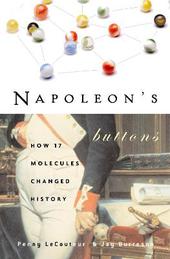
|
Napoleon'S Buttons: How 17 Molecules Changed History
Paperback / softback
Main Details
| Title |
Napoleon'S Buttons: How 17 Molecules Changed History
|
| Authors and Contributors |
By (author) Penny Le Couteur
|
|
By (author) Jay Burreson
|
| Physical Properties |
| Format:Paperback / softback | | Pages:384 | | Dimensions(mm): Height 229,Width 152 |
|
| Category/Genre | European history
World history - c 1750 to c 1900
Popular science |
|---|
| ISBN/Barcode |
9781585423316
|
| Classifications | Dewey:541.22 |
|---|
| Audience | |
|---|
|
Publishing Details |
| Publisher |
Penguin Putnam Inc
|
| Imprint |
Jeremy P Tarcher
|
| Publication Date |
24 May 2004 |
| Publication Country |
United States
|
Description
Though many factors have been proposed to explain the failure of Napoleon's 1812 Russian campaign, it has also been linked to something as small as a button, a tin button, the kind that fastened everything from the greatcoats of Napoleon's officers to the trousers of his foot soldiers. When temperature drop below 56[degrees]F, tin crumbles into powder. Were the soldiers of the Grande Armee fatally weakened by cold because the buttons of their uniforms fell apart? How different our world might be if tin did not disintegrate at low temperature and the French had continued their eastward expansion! This fascinating book tells the stories of seventeen molecules that, like the tin of those buttons, greatly influenced the course of history. These molecules provided the impetus for early exploration and made possible the ensuing voyages of discovery. They resulted in grand feats of engineering and spurred advance in medicine; lie behind changes in gender roles, in law and in the environment and have determined what we today eat, drink, and wear. Showing how a change as small as the position of an atom can lead to enormous differences in the properties of a substance, the authors reveal the astonishing chemical connections among seemingly unrelated events. Napoleon's Buttons offers a novel way to understand how our contemporary world works and how our civilization has been shaped over time.
Author Biography
Jay Burreson, Ph.D., has worked as an industrial chemist and held a National Institutes of Health special fellowship for research on chemical compounds in marine life. He is also the general manager of a high-tech company.
Reviews"Well-conceived, well-done popular science." --Booklist "Most of us never give a thought to ... the chemicals that have changed the world. This is brought out beautifully in Napoleon's Buttons, with its brilliant blending of chemistry and culture. I found it engrossing, and a delight to read." "Well-conceived, well-done popular science." --Booklist "The authors unearth a wealth of anecdotes from all parts of the world and use them effectively to illustrate the technological underpinnings of modern society. Thoughtful, often surprising, smoothly written." --Kirkus Reviews "Entertaining accounts of how various objects' chemical properties might have changed history." --Library Journal "What does the fiery compound C17H19O3N have to do with the discovery of North America? Plenty, according to this remarkable collection of scientific sleuthings. The book's cases -- especially the chapter blaming Napoleon's disastrous Russian campaign on the eponymous tin fasteners that failed to hold French uniforms together -- unfold like CSI meets the History Channel. A splendid example of better reading through chemistry. B+" --Entertainment Weekly "This book is both original and fascinating; I was quickly absorbed by this refreshing mix of science and history; I learned a lot of both and read this book quite quickly for a science book." --The Literary Flaneur
|